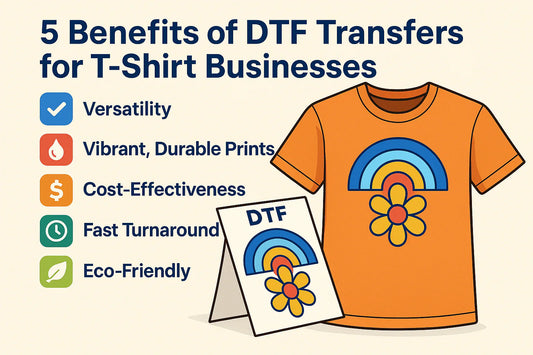DTF transfers, or Direct-to-Film transfers, have gained popularity for their vibrant colors and ability to work on various fabrics. This article explores how effective DTF transfers are on both dark and light fabrics, detailing their versatility, durability, and practical applications.
Key Takeaways
- DTF transfers are suitable for a wide range of fabrics, including cotton, polyester, and blends, ensuring bright and clear prints.
- This printing method is not limited to textiles; it can also be used on materials like wood, metal, and ceramics.
- Custom apparel like t-shirts and hoodies can be easily personalized using DTF transfers.
- Proper fabric preparation and choosing the right transfer paper are crucial for successful applications.
- DTF printing allows for complex designs with a broad color palette, making it ideal for creative projects.
Understanding DTF Transfers and Their Versatility
What is DTF Transfer Printing?
DTF, or Direct-to-Film, is a modern printing method that allows you to create custom designs on various materials. This technique involves printing your design onto a special film, which is then transferred onto the desired surface using heat. DTF printing is known for its vibrant colors and durability, making it a popular choice for custom apparel and other items.
How Does DTF Transfer Work?
The DTF transfer process is straightforward:
-
Design Creation: Start by creating your design on a computer.
-
Printing: Print the design onto a special film using a DTF printer.
-
Transfer: Use a heat press to apply the design onto the fabric or material.
This method allows for full-color designs without limitations, making it suitable for a wide range of applications.
Benefits of Using DTF Transfers
Using DTF transfers comes with several advantages:
-
Versatility: DTF can be used on various fabrics, including cotton, polyester, and blends, as well as non-fabric materials like wood and metal.
-
Durability: DTF prints are resistant to fading, ensuring that your designs remain vibrant over time.
-
Cost-Effective: Compared to traditional methods like screen printing, DTF is often more affordable, especially for small batches.
DTF printing is a game-changer in the world of custom designs, offering flexibility and high-quality results that can elevate any project.
Popular Fabrics for DTF Transfers
DTF transfers can be applied to a variety of fabrics, each with its own unique benefits. Choosing the right fabric is essential for achieving vibrant and durable prints. Here’s a closer look at some popular options:
Printing on Cotton
Cotton is a top choice for DTF transfers due to its softness and breathability. It absorbs ink well, allowing for vibrant prints. Key points include:
- Excellent adhesion
- Comfortable to wear
- Ideal for custom t-shirts
Printing on Polyester
Polyester is another great fabric for DTF transfers. It offers a smooth surface that enhances print quality. Key benefits include:
- High durability
- Vibrant colors
- Less prone to fading
Printing on Blended Fabrics
Blended fabrics, like cotton-polyester mixes, combine the best of both worlds. They provide:
- Good breathability
- Enhanced durability
- Versatile for various apparel types
Printing on Specialty Fabrics
Specialty fabrics, such as nylon and treated leather, can also be used for DTF transfers. However, they require careful handling:
- Ensure proper heat settings
- Test on a small area first
- Ideal for unique custom designs
DTF transfers work well on many fabrics, including cotton and leather. This versatility allows for custom iron-on DTF transfers that can withstand over 45 washes without fading. Understanding the fabric's properties can help you create stunning custom apparel.
Durability and Longevity of DTF Transfers
How Long Do DTF Transfers Last?
DTF transfers are known for their exceptional durability. With proper care, they can withstand over 45 washes without fading or cracking. This makes them a great choice for custom apparel that needs to last.
Preventing Color Fading
To keep your DTF transfers looking vibrant:
- Always wash garments inside out.
- Use cold water and a gentle cycle.
- Avoid bleach, as it can cause fading.
Maintaining Your DTF Printed Items
For long-lasting results, follow these tips:
- Store items in a cool, dry place.
- Avoid folding them in a way that puts pressure on the transfer.
- If you notice any peeling or cracking, address it immediately to prevent further damage.
By following these simple care instructions, you can ensure your DTF transfers remain vibrant and durable for a long time. No peeling, no wrinkles—just beautiful, lasting designs.
Comparing DTF with Other Printing Methods
DTF vs. Screen Printing
When looking at DTF Transfer printing and screen printing, there are some important differences:
-
Setup Costs: DTF is cheaper to start because it doesn’t need multiple screens for different colors.
-
Design Complexity: DTF is better for detailed designs and bright colors, making it great for small orders. Screen printing works better for larger batches.
-
Durability: Both methods are durable, but DTF prints can feel a bit plastic-like.
DTF vs. DTG Printing
DTG (Direct-to-Garment) printing is another popular method. Here’s how they compare:
| Feature |
DTF Printing |
DTG Printing |
| Investment |
Lower initial cost |
Higher initial cost |
| Production Speed |
Slower due to steps |
Faster, prints directly on fabric |
| Color Quality |
Excellent for full-color designs |
Great, but varies by fabric |
| Fabric Compatibility |
Works on various fabrics |
Best on cotton |
DTF vs. White Toner Printing
White toner printing is another method to consider:
-
Process Complexity: DTF is simpler because it prints the white layer with the color layer, while white toner needs separate steps.
-
Cost Efficiency: DTF is usually cheaper, with lower costs for materials.
-
Print Feel: Both methods have a similar finish, but DTF inks are more elastic and resistant to wear.
In summary, DTF printing is a flexible and cost-effective way to create bright, full-color designs on many fabrics. It stands out against traditional methods like screen printing and DTG, making it a strong choice for custom projects.
Special Considerations for Different Materials
Pre-Pressing the Fabric
Before applying DTF transfers, pre-pressing the fabric is essential. This step helps to remove any moisture and ensures better adhesion. Here are some key points to remember:
- Always pre-press for about 5 seconds.
- Use a medium pressure to flatten the fabric.
- This step is crucial for achieving vibrant prints.
Adjusting Temperature Settings
Different fabrics require different heat settings. Here’s a quick guide:
| Fabric Type |
Recommended Temperature |
| Cotton |
320°F (160°C) |
| Polyester |
320°F (160°C) |
| Nylon |
300°F (150°C) |
- Always check the fabric label for specific instructions.
- Adjust the pressure based on the thickness of the fabric.
Testing on a Small Area First
Before applying the transfer to the entire garment, it’s wise to test on a small area. This helps to:
- Ensure compatibility with the fabric.
- Check for any adverse reactions.
- Confirm that the colors appear as expected.
Taking these special considerations into account can significantly improve the quality of your DTF transfers. Proper preparation leads to stunning results that last longer and look great!
Achieving the Best Results with DTF Transfers

Using High-Quality Custom Iron-On Transfers
To get the best results with DTF transfers, using high-quality custom iron-on transfers is essential. These transfers are designed to adhere well to various fabrics, ensuring vibrant and long-lasting designs. Here are some tips:
- Choose transfers specifically made for dark fabrics.
- Ensure the design is printed with high-resolution settings.
- Look for transfers that offer a wide color range without extra charges.
Setting the Heat Press Correctly
Setting the heat press correctly is crucial for successful DTF application. Follow these steps:
- Preheat the heat press to the recommended temperature (usually around 320°F or 160°C).
- Pre-press the fabric for about 5 seconds to remove moisture.
- Apply the transfer with medium to high pressure for about 15 seconds.
Storing Transfers Properly
Proper storage of your DTF transfers can help maintain their quality. Here are some storage tips:
- Keep transfers in a cool, dry place.
- Avoid stacking heavy items on top of them.
- Store them flat to prevent creasing.
DTF allows for vibrant, full-color designs without color limitations, making it suitable for various fabrics including cotton and leather. Durability is a key advantage of DTF transfers, ensuring your designs last longer than traditional methods.
Applying DTF Transfers to Various Apparel Types

Custom T-Shirts and Hoodies
DTF transfers are perfect for custom apparel printing like t-shirts and hoodies. They allow for vibrant designs that stand out. Here are some key points:
-
Comfortable Fit: DTF transfers work well on cotton and polyester blends, ensuring a soft feel.
-
Durability: The prints are long-lasting and can withstand multiple washes without fading.
-
Design Flexibility: You can create unique designs for any occasion, from casual wear to special events.
Sportswear and Jerseys
When it comes to sportswear, DTF transfers shine. They are ideal for jerseys and athletic gear. Here’s why:
-
Breathable Fabrics: DTF works well on moisture-wicking materials, keeping athletes comfortable.
-
Team Spirit: Easily customize jerseys with team logos and player names.
-
Durable Prints: The transfers are designed to last, even with heavy use.
Accessories Like Hats and Bags
DTF transfers can also be applied to various accessories, making them versatile for custom designs:
-
Hats: Perfect for adding logos or fun designs.
-
Bags: Great for personalizing tote bags or backpacks.
-
Unique Touch: DTF allows for intricate designs that can make any accessory stand out.
DTF transfers provide a fantastic way to personalize your apparel and accessories, making them unique and special. Whether for personal use or business, the possibilities are endless!
Conclusion
In conclusion, DTF transfers are effective for both dark and light fabrics. This printing method allows for bright and colorful designs that look great on many materials. Whether you're using cotton, polyester, or even leather, DTF transfers can give you the results you want. They are durable and can last through many washes without fading. So, if you're looking to create custom items, DTF transfers are a smart choice. Just remember to follow the right steps for the best outcome, and enjoy making your unique designs!
Frequently Asked Questions
What is DTF transfer printing?
DTF transfer printing, or Direct-to-Film printing, is a method where designs are printed onto a special film and then transferred to fabrics using heat.
Can I use DTF transfers on dark fabrics?
Yes, DTF transfers work well on dark fabrics, but proper preparation and settings are key to achieving vibrant results.
How long do DTF transfers last?
With the right care, DTF transfers can last through many washes without fading or peeling.
What types of fabrics are best for DTF transfers?
DTF transfers are compatible with various fabrics like cotton, polyester, and blends, as well as specialty materials like leather.
Are there any color limits with DTF printing?
No, DTF printing allows for unlimited colors, so you can create vibrant, full-color designs without extra costs.
How do I apply DTF transfers?
You can apply DTF transfers using a heat press or an iron, following the recommended temperature and pressure guidelines for best results.











0 comments